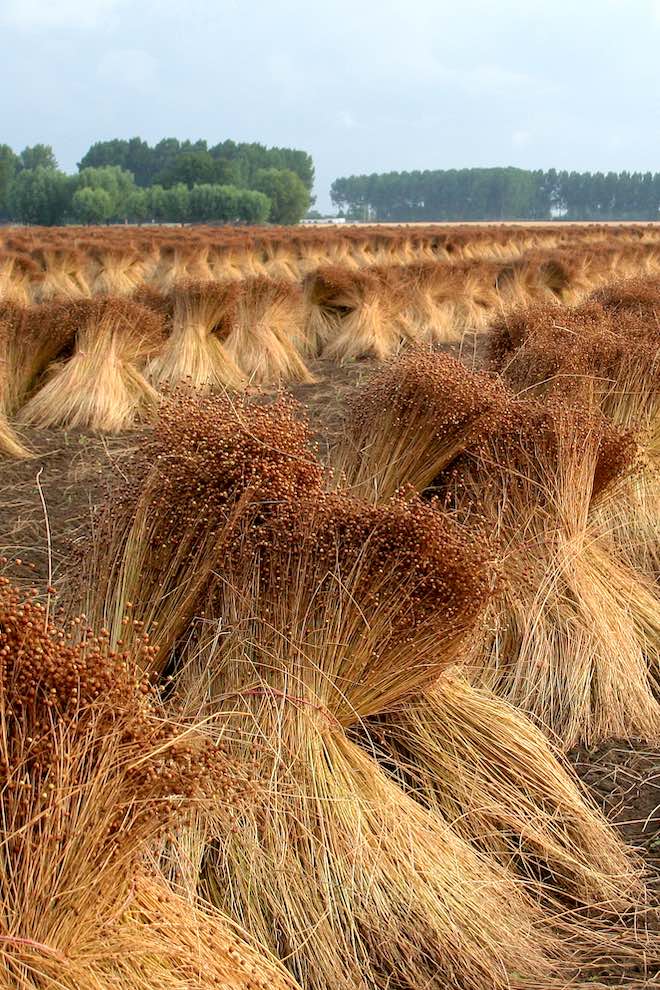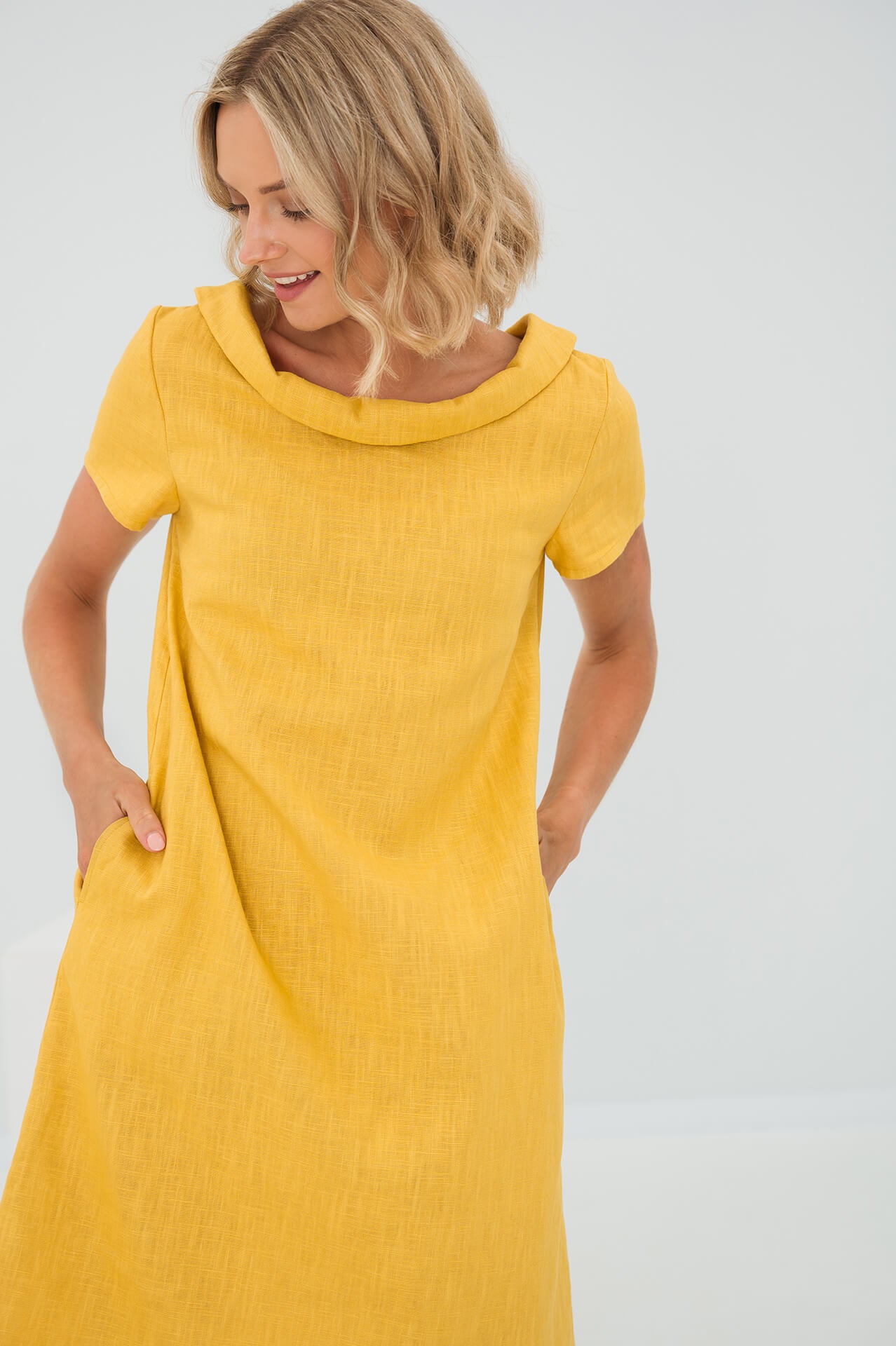In this article we will cover the following questions:
What is linen?
Linen is a natural textile and its source is the flax plant, one of the oldest cultivated plants in our civilization. The flax plant is an annual crop that is highly cultivated in cooler areas of the world. The linen fabric is made from the fibers that grow inside of the plant. Over the course of time, people have invented and used certain techniques for flax processing. The fibers of the flax plant are naturally strong but nevertheless must be extracted with special care in order to avoid any possible damage and ensure the making of a high-quality linen fabric.
The making process of linen
The linen fibers from the flax plant go trough quite a journey to reach the stage of the lushly textured material. Take a look at the whole process from the flax plant to your gorgeous linen dress.
1. Cultivating of flax
It all starts from planting small and glossy golden-brown seeds that are shaped in a similar way like the pips of an apple. The flax plant thrives in a colder environment, therefore the planting schedule of the plant depends on the climate of the country where it is being cultivated. This being said, in some places of the world flax is sown in the wintertime so that the heat of spring could be avoided. The seeds of flax plant are planted in a shallow manner. Whether in commercial production or not, they can be distributed by hand or using machines. When the seeds are planted, they must be covered with soil.
2. Harvesting
The flax plant can be harvested after approximately 100 days. The harvest time is usually known by seeing the stem turning yellow and the seeds turning brown. Thus, the flax is finally ready to be pulled.
The stems of the plant are then removed from the ground leaving the roots intact. If the stalk that contains the stems would be cut, it would seriously impact the quality of the linen. The stalks are pulled by hand or using the machines, however, the best quality linen comes from the ones that were pulled manually. This is because mechanized harvesting is not perfect and is yet unable to protect the entirety of the roots.
The stalks of the flax plant are stacked to dry. They dry in open air for several weeks.
3. Extracting the fibers from the stalks
- The stalks undergo removal of the seeds and leaves. It can be done by hand or using coarse combs. Nowadays the process is mechanized almost everywhere.
- The stalks are beaten and the seed pods are crushed, then the seeds are removed.
- The retting process begins. It can be achieved by various ways, nonetheless, it shall be executed with great care so that the delicate fibers stay intact. Too much retting can weaken the fibers and therefore, ruin the quality of the material.
- Some places do the manual retting, where the stems that contain the fibers are placed in water. It could vary from bogs and steams to tanks or pools. The fermenting of the stems might take a couple of weeks or more.
- The time of retting depends on the temperature of water as well as natural occurrences of the sun, wind, dew and ever-present bacteria, micro fauna.
- The most popular way of retting nowadays is by using chemicals. The stems of a flax plant are placed in a certain solution (oxalic or alkali acid) then pressured and boiled. This method of retting is fairly quicker than hand retting, although some consider the latter mentioned method ensures a better quality of linen fabric.
- When the retting is over it is time for the breaking process. Nevertheless, before it takes place, the flax plants are squeezed and left to dry. The breaking is necessary in order to remove the woody stalks that are still apparent on the fibers.
- The retted stalks, that are also called straw, are passed trough rollers that crush the pieces of wood into small pieces, so that they could be removed easily.
- A process of scutching takes place. It can be manual or performed by a scutching machine. If performed manually, the broken parts of wood are removed and pulled away using a small wooden knife down the length of the flax fibers.
- When scutching is performed by a machine, the broken shives of wood are removed using rotating paddles.
- The separated fibers are combed (or hackled) using a bed of nails that separates shorter fibers from the longer ones. The short fibers are called tow fibers and they are used to in a production of low-quality linen.
- The longer fibers of flax are continuing their journey. The fibers of 12 - 20 in or 30.5 - 51 cm are considered luxurious and called line or dressed flax. Now it is time to move on to spinning.
4. Spinning
- Separated flax fibers are put trough spreaders, the machines that combine the fibers of the same length. The machine then lays the fibers parallel so that the ends overlap, thus creating a sliver. The sliver goes trough rollers and a roving comes out, which then can be spun.
- The strands of fiber or the linen rovings are put on a spinning frame and drawn into a thread. The yarns are being formed and then wounded on spools or bobbins. During the spinning process, the yarns are always slightly dampened to ensure no fly-away strands and smoothness of a yarn.
- Flax is spun neatly and finely resulting in a thin yarn of long fibers. A thicker yarn is created out of multiple thin yarns being spun in a process called plying. The result: a thicker yarn (3-ply or more) is then finished off by boiling in soapy water, leaving it shiny.
5. Weaving
A linen yarn is being woven into lengths of linen fabric. The process dictates that multiple threads are interlaced horizontally and vertically on a loom. Linen yarn can also be knit, although linen has no real elasticity making the latter action extremely difficult.
6. Bleaching and dyeing the fabric
One of the final steps to get to your piece of linen clothing is the bleaching and dyeing of the linen fabric. Sometimes linen fabric is left untouched and is usually distinguished by its gray colour. However, there are different shades of gray and the colour of the natural linen material is heavily influenced by all the processes it overcame before becoming a fabric.
Usually, linen material that is meant for clothing, as well as home textile, is bleached and then dyed. Linen is a natural fabric, thus, it takes the dye better than any synthetic materials. Nowadays there is a huge variety of colours, therefore, you can easily come across white or deep blue bed sheets, a linen dress in orange, or a pink linen towel. It all depends on your wishes and imagination!
Cultivation of linen in Lithuania
Lithuania and the Baltic region is one of the places in the world where linen textile is highly valued and cherished. Cultivating and producing linen in Lithuania has deep roots as linen is an extraordinarily important part of Lithuanian cultural heritage. Linen is also found in traditional Lithuanian clothing.
The best qualities of linen
Linen has so many good qualities that it can easily be called a “super-fabric”. The textile is temperature controlling, in other words: when it’s hot it cools you down and when it’s cold it traps the warmth under. The material doesn’t wear down easily, on the contrary, the more you wear it the more comfortable and soft it gets. Besides, linen fabric is perfect for people suffering from various allergies as it is hypoallergenic! In addition to already mentioned qualities, linen also has the ability to dry very quickly. Finally, linen is natural so it is most definitely a hundred percent biodegradable material.
For extra tips on how to care for and wash your linen products, take a look at this article.
All in all, linen fabric is, indeed, a remarkable choice. Linen clothing is a great sustainable fashion choice too. A material, possessing rich history, created from the natural sources and easily navigating its way to the hearts of the people. Get on board and try this natural fabric to feel the pleasantness yourself!




Leave a comment
This site is protected by hCaptcha and the hCaptcha Privacy Policy and Terms of Service apply.